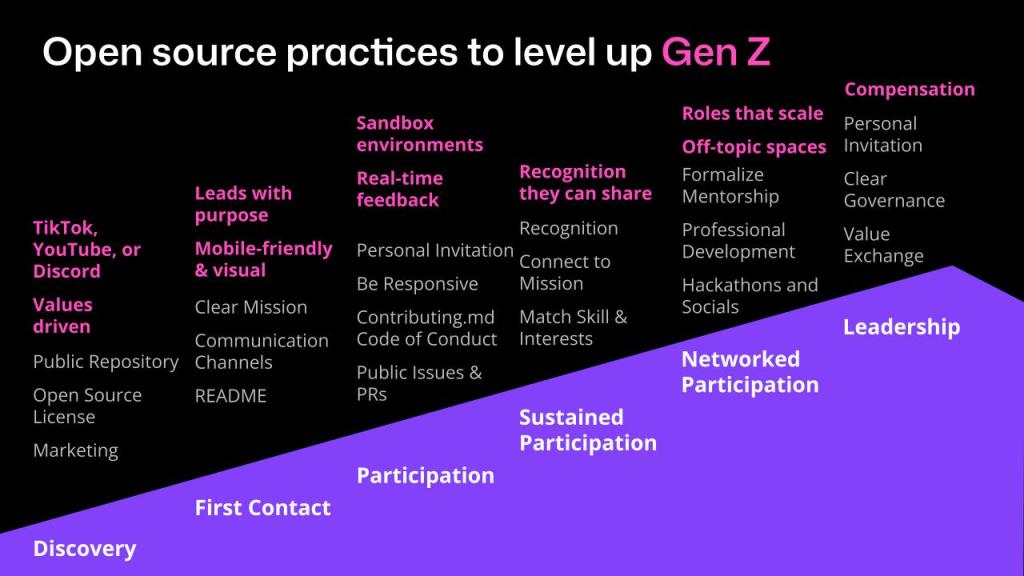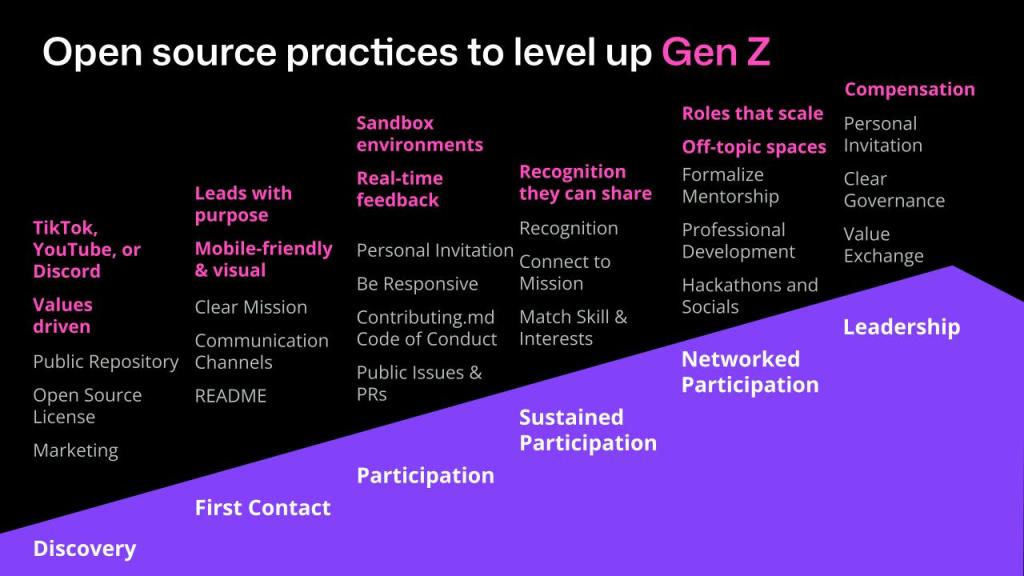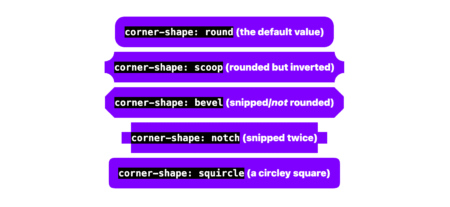When I was a first-year student, I joined a campus club after seeing a flyer in the hallway. I didn’t know much about it — only that my mom had been part of the same group when she was in university, and it had shaped her life. At the first meeting, I found instant community. Some of those people became lifelong friends. But they were also mostly in their third or fourth year.
The next year, most of them graduated and there was a huge leadership gap. I wasn’t ready, but I stepped up.
That experience taught me something I’ll never forget: If you don’t bring in new people early, your community won’t last.
Years later, I’m seeing the same pattern in open source. We talk a lot about burnout, bus factors, and maintainers leaving — but we don’t talk enough about how to bring in new contributors, or what it takes to help them grow into leaders.
The graying of Open Source
According to Tidelift’s 2024 maintainer survey, the percentage of maintainers aged 46–65 has doubled since 2021. Meanwhile, the share of contributors under 26 has dropped from 25% to just 10%.
This “graying” isn’t inherently a problem. But the lack of succession is. If we don’t create pathways for younger contributors, we’re setting ourselves up for burnout, knowledge loss, and long-term fragility.
Enter Sam: A Gen Z persona
To explore what support might look like, I introduced a persona named “Sam” in a recent talk at Open Source Summit North America:
- Name: Sam (they/them)
- Age: 23
- Location: Urban Canada, lives mostly online
- Sentiment: “I want to contribute to a climate tech project that actually matters — but I don’t know where to start. I taught myself to code on YouTube. I design and moderate online communities. But public repos feel intimidating. I want purpose, flexibility, and a place where people like me belong.”
Sam is our Gen Z persona. They want to contribute to something that matters. They’re self-taught, community-oriented, and motivated by purpose. But they’re also navigating financial pressures, unclear pathways, and they aren’t sure how leadership in open source actually works.
How do we help Sam thrive in open source?
The mountain of engagement
To support contributors like Sam, here’s a framework I’ve used for years in programs like Mozilla Open Leaders and GitHub’s Maintainer Programs: the Mountain of Engagement.
This model outlines a contributor’s journey in six steps:
- Discovery: How they first hear about the project.
- First contact: How they first engage with the project or their initial interaction.
- Participation: How they first participate or contribute.
- Sustained participation: How their contribution or involvement can continue.
- Networked participation: How they may invite and onboard others or networking within the community.
- Leadership: How they may take on some additional responsibility on the project, or begin to lead.
At each stage, you can compare traditional best practices with what Gen Z contributors like Sam might actually need.
1. Discovery
How they first hear about the project.
Traditional approach: Make your project discoverable. That means publishing to a public repository, applying an open source license, and doing basic marketing: a project website, documentation, and maybe a few social posts.
What Sam needs: Sam isn’t browsing GitHub trending pages. They’re discovering projects through TikTok, Discord, and YouTube. They want to see purpose up front, not buried in a README. And their learning starts on mobile.
- 84% of Gen Z are on YouTube (Sprout Social Index, 2025)
- 86% say purpose is very or somewhat important for their job satisfaction. (Deloitte, 2025)
To reach Sam, projects need to show up where they already are, with formats and values that resonate.
2. First contact
How they first engage with the project, their initial interaction.
Traditional approach: A good README, clear contributing docs, and a communication channel where newcomers can ask questions.
What Sam needs: A mobile-friendly, visual-first landing experience. A project that leads with its mission. A casual, open chat like Discord where they can lurk before jumping in.
- 72.8% of Gen Z prefer visual learning. (TJHSS, 2025)
Gen Z favors community-driven platforms like Discord over public forums. (Impero, 2022)
3. Participation
How they first participate or contribute.
Traditional approach: Personal invitations, fast responses to questions, “good first issues,” and clear contribution docs. These reduce friction and help people get started.
What Sam needs: Real-time feedback. Sandboxed environments to try things out. Clear spaces where it’s okay to learn, not just perform.
- Generation Z students tend to be keen observers; they prefer to watch others complete tasks before attempting them themselves. (TJHSS, 2025)
Projects like FreeCodeCamp and Kubernetes’ contributor playgrounds offer great models here.
4. Sustained participation
How their contribution or involvement can continue.
Traditional approach: Recognize contributors, match tasks to interests, and show how their work connects to the project’s mission.
What Sam needs: Recognition they can share: badges, mentions, portfolios. They care about making a difference more than climbing a hierarchy. Show impact.
- 86% of Gen Z workers prioritize mentorship and skill development. (Deloitte, 2025)
5. Networked participation
How they may invite and onboard others, networking within the community.
Traditional approach: Mentorship, social events, and formal roles that build commitment and connection.
What Sam needs: Named, shareable roles like Discord mod or community guide. Off-topic channels and casual connection. Peer-led leadership that spreads influence.
- 70% of Gen Z join communities for belonging and voice. (Impero, 2022)
Rust’s consensus-driven governance is an example.
6. Leadership
How they may take on some additional responsibility on the project, or begin to lead.
Traditional approach: Invite someone to become a maintainer. Share governance. Provide documentation on roles and responsibilities.
What Sam needs: Shared stewardship, not top-down control. Compensation or professional growth. A clear value exchange.
- 52% of Gen Z live paycheck to paycheck. (Deloitte, 2024)
They’re more likely to contribute when there’s tangible support: mentorship, visibility, or paid time.
TensorFlow’s contribution ladder and For Good First Issue’s mission-based focus both offer promising examples.
What you can do
Open source won’t thrive without the next generation. Let’s build projects where contributors like Sam feel welcome, supported, and seen.
Here are a few concrete actions you can take this week:
- Turn your
READMEinto a 60-second explainer video. - Create a sandbox space for first-time contributors.
- Start a Discord or off-topic channel to foster belonging.
- Make your project’s mission loud and visible.
Ask yourself: “What does a thriving project look like to Sam? What would it take for them to stay for five years, not five weeks?”
Let’s build a future together

Maintaining open source isn’t just about keeping the lights on. It’s about creating space for the next generation.
Want to go deeper? Take a look at my slides (with speaker notes + references).
Let’s build an ecosystem where maintainers are supported, projects thrive, and people like Sam stay for years — not weeks.
Read more open source stories on the GitHub Blog >
References
- Tidelift (2024). The 2024 Tidelift State of the Open Source Maintainer Report
- Impero (2022). Community research on Gen Z online confidence
- McKinsey (2022). American Opportunity Survey on Gen Z workplace perspectives
- Deloitte (2025). Global Gen Z and Millennial Survey
- EIM Partnerships (2024). Gen Z Learning Style Research
- Pew Research Center (2024). Teens, Social Media, and Technology
- CAKE.com (2024). Gen Z Workforce Statistics
- University of Waterloo Work-Learn Institute (2023). Future Workforce Perspectives Survey
- Transcultural Journal of Humanities and Social Sciences (2025) Teaching the Digital Natives: Examining the Learning Needs and Preferences of Gen Z Learners in Higher Education
- Common Sense Media (2022) The Common Sense Census: Media Use by Tweens and Teens
- Sprout Social Index (2025). Gen Z Social Media Usage Statistics
- Statista (2023). Share of YouTube Consumption Time in the United States in 2023, by Generation
The post Who will maintain the future? Rethinking open source leadership for a new generation appeared first on The GitHub Blog.
Source: Read MoreÂ

